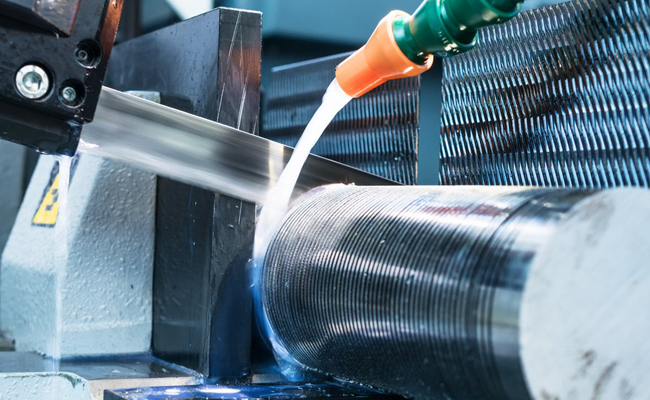Cooling Effect
-
Core Mechanism: Rapidly reduces the temperature in the area of the saw blade teeth and the workpiece cut through heat absorption and dissipation.
-
Importance: Prevents the saw blade from losing hardness and experiencing accelerated wear due to annealing caused by high temperatures. Also prevents workpiece deformation or changes in metallographic structure due to localized high temperatures, which could affect subsequent processing quality.

Automatic bandsaw sawing metal workpiece. From the cooling pipes supplied lubricity emulsion.
Lubrication Effect
-
Core Mechanism: Forms a lubricating film between the saw blade teeth and the workpiece.
-
Importance: Reduces friction between the rake face, flank face, the chips, and the workpiece. This directly decreases cutting resistance, saves energy consumption, significantly reduces tooth wear, extends saw blade life, and results in a smoother cut surface.
Cleaning and Chip Removal Effect
-
Core Mechanism: Utilizes high-speed fluid flow to wash away chips.
-
Importance: Prevents metal chips from accumulating in the cut and the gaps between the teeth. Chip accumulation can lead to the saw blade jamming, tooth pulling, tooth breakage, and a rough cut surface due to secondary friction. It also cleans the equipment, preventing chips from causing wear to guide rails and transmission components.
Anti-Rust Effect
-
Core Mechanism: Anti-rust additives in the cutting fluid form a protective film on the saw blade, workpiece, and machine tool surfaces, isolating them from air and moisture.
-
Importance: Protects expensive saw blades and the equipment itself from rusting in the humid processing environment. It also ensures the workpiece does not corrode during transfer between processing stages.
Antibacterial & Environmental Considerations
-
Your mention of “preventing bacterial growth” and “properly disposing of waste fluid” is very important. This falls under the category of cutting fluid maintenance and management.
-
Reason: Water-based cutting fluids are a breeding ground for microorganisms. Once they deteriorate, they lose effectiveness, develop odors, and can corrode equipment and workpieces.
-
Requirement: Concentration and pH must be monitored regularly, and fluids should be changed on schedule. Waste fluid contains oils and chemicals and must not be discharged arbitrarily; it needs to be handled by qualified organizations to comply with environmental regulations.
Summary
Your description of the functions of cutting fluid is very accurate and professional. To summarize: Through the synergistic effects of cooling, lubrication, cleaning, and rust prevention, cutting fluid collectively ensures that band saw machines can achieve efficient, high-quality, and cost-effective sawing operations while protecting the expensive saw blades and equipment. Furthermore, the maintenance and environmental considerations you mentioned are crucial for ensuring these functions can be sustained effectively in practical production, which is vitally important.